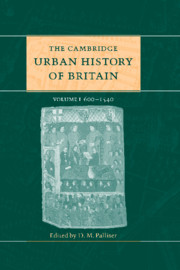Book contents
- Frontmatter
- Part I Introductory
- Part II The early middle ages 600–1300
- Part III The later middle ages 1300–1540
- 12 General survey 1300–1540
- 13 Government, power and authority 1300–1540
- 14 The economy of British towns 1300–1540
- 15 Urban culture and the Church 1300–1540
- 16 The built environment 1300–1540
- 17 London 1300–1540
- 18 The greater towns 1300–1540
- 19 Port towns
- 20 Small towns 1270–1540
- Part IV Regional surveys
- Part V Conclusion
- Appendix: Ranking lists of English medieval towns
- Select bibliography
- Index
- References
17 - London 1300–1540
from Part III - The later middle ages 1300–1540
Published online by Cambridge University Press: 28 March 2008
- Frontmatter
- Part I Introductory
- Part II The early middle ages 600–1300
- Part III The later middle ages 1300–1540
- 12 General survey 1300–1540
- 13 Government, power and authority 1300–1540
- 14 The economy of British towns 1300–1540
- 15 Urban culture and the Church 1300–1540
- 16 The built environment 1300–1540
- 17 London 1300–1540
- 18 The greater towns 1300–1540
- 19 Port towns
- 20 Small towns 1270–1540
- Part IV Regional surveys
- Part V Conclusion
- Appendix: Ranking lists of English medieval towns
- Select bibliography
- Index
- References
Summary
By the early fourteenth century London was pre-eminent among English urban communities. Whether ranked according to wealth or according to population, its pre-eminence was undisputed. Although London was larger, more populous and wealthier than other English towns, it was distinguished from them not only by size and volume: it developed, in the period covered here, characteristics which were distinctive. London was different not only in scale, but also in kind.
This pre-eminence is reflected in the creation and for the most part survival of a remarkable series of administrative records. Although the chamberlain's records (including the apprentice and freedom registers) were destroyed in a fire in the seventeenth century, the City is rich in custumals, record books and wills and deeds enrolled in the Husting court from the mid-thirteenth century. The pleadings in the mayor's court survive from the end of the thirteenth century and the records of the meetings of the court of aldermen and court of Common Council from 1416. In addition to the City's official records, there survive thousands of testaments enrolled in the ecclesiastical courts, pre-Reformation records of some thirty of London's parish churches and material of great interest from the archives of the livery companies. Much of this material, particularly that from the city's own administration, has been edited and calendared. Moreover, in the late fourteenth and fifteenth centuries the Londoners developed a taste for ‘London chronicles’, i.e. histories of England written in the vernacular and divided into mayoral, rather than regnal, years. These chronicles throw some fitful light upon the course of English history, but rather more light on the thought-world of the Londoners who commissioned and bought them.
- Type
- Chapter
- Information
- The Cambridge Urban History of Britain , pp. 395 - 440Publisher: Cambridge University PressPrint publication year: 2000
References
- 10
- Cited by



